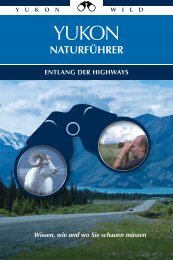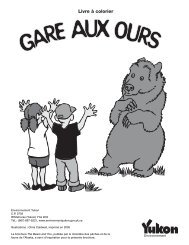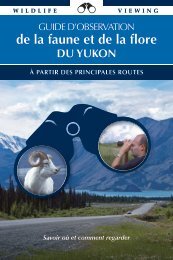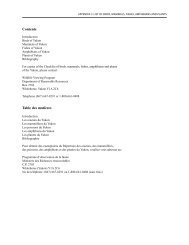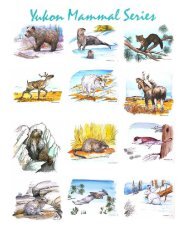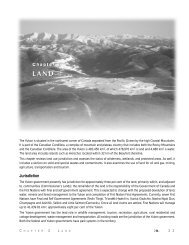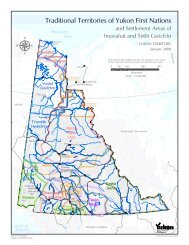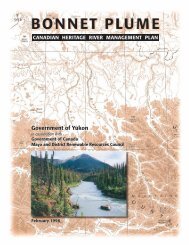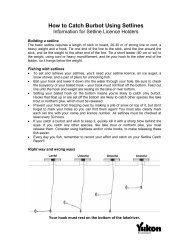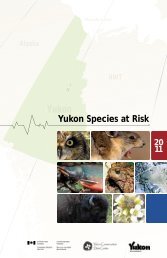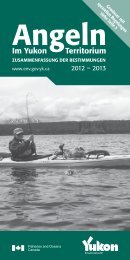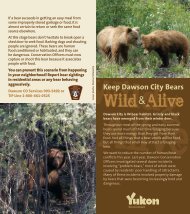Yukon Stocked Lakes
Yukon Stocked Lakes
Yukon Stocked Lakes
Create successful ePaper yourself
Turn your PDF publications into a flip-book with our unique Google optimized e-Paper software.
Anglers’ Guide to<br />
<strong>Yukon</strong> <strong>Stocked</strong> <strong>Lakes</strong>
Contents<br />
<strong>Stocked</strong> <strong>Lakes</strong> Program 1<br />
<strong>Yukon</strong> <strong>Stocked</strong> <strong>Lakes</strong> Map 2<br />
<strong>Stocked</strong> Fish Species 4<br />
Catching More Fish in <strong>Stocked</strong> <strong>Lakes</strong> 6<br />
WHITEHORSE AREA<br />
Hidden <strong>Lakes</strong> 10<br />
Chadden Lake 12<br />
Long Lake 14<br />
Cantlie Lake 16<br />
Scout Lake 18<br />
Judas Lake 20<br />
Marcella Lake 22<br />
Salmo Lake 24<br />
WATSON LAKE AREA<br />
Hour Lake 26<br />
Lucky Lake 27<br />
Rantin Lake 28<br />
Veronica Lake 30<br />
CENTRAL YUKON<br />
Gloria Lake II 32<br />
Wrong Lake 34<br />
Fisheye Lake 36<br />
Coffee Lake 38<br />
Whiskers Lake 39<br />
Haldane Lake 40<br />
© MARCH 2012<br />
Cover image: D. Zimmermann<br />
Additional copies of this publication can be obtained<br />
at any Environment <strong>Yukon</strong> office or by contacting:<br />
Environment <strong>Yukon</strong><br />
PO Box 2703<br />
Whitehorse, <strong>Yukon</strong> Y1A 2C6<br />
Tel: (867) 667-5721<br />
fisheries@gov.yk.ca<br />
ISBN: 978-1-55362-571-1
<strong>Stocked</strong> <strong>Lakes</strong> Program<br />
Good Fishing – Easy Access<br />
<strong>Yukon</strong> residents and visitors have been enjoying the benefits of stocked fish since the Alaska<br />
Highway was opened to public travel in the late 1940s. Today, Environment <strong>Yukon</strong>’s Fisheries Section<br />
works closely with the <strong>Yukon</strong> Fish and Game Association to provide good fishing opportunities within<br />
easy access of most communities.<br />
You can easily reach most of the lakes listed in this booklet, driving to the shoreline of many of<br />
them. A few require a short walk on trails no longer than 1 km. Access roads are not maintained<br />
through the winter but hard-packed snowmobile trails usually provide easy access for ice fishing.<br />
Twenty lakes are stocked with rainbow trout, Arctic char, kokanee salmon or bull trout. <strong>Stocked</strong> lakes<br />
not only provide good fishing, they also take angling pressure off slow-growing wild fish species<br />
such as lake trout.<br />
Fishing regulations<br />
You must have a valid <strong>Yukon</strong> Angling Licence if you want to fish in stocked lakes. <strong>Stocked</strong> lakes<br />
have specific fishing regulations, and daily catch limits for stocked fish are often higher than for<br />
wild fish. Pick up the <strong>Yukon</strong> Fishing Regulations Summary to read about the rules that apply.<br />
Protecting the environment<br />
• Bring out all your garbage, especially old fishing line.<br />
• If you want to build a campfire, use an existing fire circle and burn dead wood only. Don’t build a<br />
fire if the risk of forest fire is high. Make sure your fire is completely out before you leave.<br />
• If you have to go, bury human waste out of sight and at least 60 m away from water.<br />
For information on live release, see inside back cover.<br />
More Information<br />
Want to find up-to-date stocking records, more stocked lakes maps, license requirements, as well<br />
as other information on fishing in <strong>Yukon</strong>?<br />
Please visit our website at:<br />
www.env.gov.yk.ca/fishing
±<br />
ALASKA<br />
YUKON<br />
!<br />
Wrangell St. Elias<br />
National Park<br />
GULF<br />
OF ALASKA<br />
Beaver Creek<br />
Alaska Hwy<br />
Kluane<br />
Wildlife Sanctuary<br />
Kluane<br />
National Park<br />
Dawson<br />
!<br />
!<br />
Ste w art River<br />
YUKON RI VER<br />
Burwash Landing<br />
Kluane<br />
Lake<br />
Haines Junction<br />
Alsek R i ver<br />
!<br />
Tatshenshini - Alsek<br />
Provincial Park<br />
Stewart Crossing<br />
Wrong Lake p.34<br />
Pelly Crossing<br />
Gloria Lake ll p.32<br />
Aishihik<br />
Lake<br />
Haines Rd<br />
Haldane Lake p.40<br />
!<br />
!<br />
Carmacks<br />
Silver Trail<br />
!<br />
North Klondike Hwy<br />
Kusawa<br />
Lake<br />
YUKON<br />
BRITISH COLUMBIA<br />
!<br />
Mayo<br />
Scout Lake p.18<br />
WHITEHORSE<br />
Chadden Lake p.12<br />
!<br />
Robert Campbell Hwy<br />
Lake<br />
Laberge<br />
!\<br />
!<br />
<strong>Yukon</strong> <strong>Stocked</strong> <strong>Lakes</strong><br />
2 3<br />
!<br />
Pell y River<br />
Teslin River<br />
Hidden <strong>Lakes</strong> p.10<br />
Cantlie Lake p.16<br />
Marsh<br />
Judas Lake p.20 Lake<br />
Carcross<br />
S Klondike Hwy<br />
Keno City<br />
Long Lake p.14<br />
Tagish<br />
Tagish<br />
Lake<br />
Fisheye Lake p.36<br />
!<br />
Faro<br />
Alaska<br />
Teslin<br />
Lake<br />
Marcella Lake p.22<br />
Atlin<br />
Lake<br />
Whiskers Lake p.39<br />
!<br />
!<br />
Teslin<br />
Ross River<br />
Coffee Lake p.38<br />
Salmo Lake p.24<br />
Hwy<br />
Wolf<br />
Lake<br />
Veronica Lake p.30<br />
0 50 100 km<br />
YUKON<br />
NWT<br />
Frances<br />
Lake<br />
Rantin Lake p.28<br />
Lucky Lake p.27<br />
Hour Lake p.26<br />
!<br />
Watson Lake<br />
Li a r d R.
<strong>Stocked</strong> Fish Species<br />
RAINBOW TROUT<br />
Rainbow trout have been stocked successfully in <strong>Yukon</strong> for<br />
over 60 years. The rainbow is popular with anglers, especially<br />
fly fishing anglers, because it has a beautiful appearance,<br />
strikes vigorously at artificial lures as well as natural baits,<br />
fights aggressively, and tastes great.<br />
This trout has a light-coloured body sprinkled with black spots,<br />
which line up in radiating rows on the tail. Its name comes from the broad stroke of pinkish colour<br />
which runs down the side of the fish from its head to near its tail. As with most fish, the back is<br />
darker than the sides. The fine tasting flesh ranges from white to bright red in colour, depending<br />
on the fish’s diet. Rainbow trout eat insects, plankton, crustaceans, fish eggs and small fish. Their<br />
habit of taking adult insects on the surface makes dry fly fishing particularly effective.<br />
Rainbows can live as long as 11 years but the normal life span is 4 to 6 years. Rainbows stocked in<br />
small pothole lakes seldom reproduce.<br />
ARCTIC CHAR<br />
This fish has many of the characteristics that have made<br />
rainbow trout so popular. Char can be caught on streamers and<br />
occasionally on dry flies, but a flashy spoon is considered most<br />
effective. Small char may jump several times when hooked. Ice<br />
fishing anglers catch this fish on spoons and jigs.<br />
The Arctic char has a slightly forked tail and a dark body covered<br />
with light spots, except for the head. Although its colour can vary tremendously, this fish is normally<br />
silvery-green on its sides with large pink, red or cream-coloured spots. The lower fins have white<br />
leading edges. The flesh colour varies from white to red, depending on the fish’s diet. Young char<br />
feed heavily on shrimp and insect larvae. Adult char feed mainly on small fish and insect larvae<br />
found on lake bottoms.<br />
Wild char populations usually spawn in September or October. Char stocked in Cantlie Lake have<br />
been reproducing naturally since the 1990s, and in past years Fisheries staff have used this lake as<br />
a source for Arctic char eggs for the Whitehorse Rapids Fish Hatchery. Arctic char may live as long<br />
as 15 years but they grow slowly, especially after they reach 10 years of age. Arctic char have been<br />
stocked in <strong>Yukon</strong> lakes for more than 20 years.<br />
BULL TROUT<br />
Bull trout have dark green or brown upper bodies fading to a<br />
light belly, with pink, orange or red spots along their back and<br />
sides. They have a large head, and white leading edges on their<br />
fins. Bull trout have long been confused with Dolly Varden.<br />
We now know they are a distinct species and occupy different<br />
geographic ranges in <strong>Yukon</strong>. Bull trout differ in appearance from<br />
Dolly Varden in that they have no black spots on their dorsal fins, and their eyes are closer to the top<br />
of their heads. Their diet is made up of aquatic and terrestrial invertebrates and small fish. Spawning<br />
occurs in fall over gravel stream beds, and spawning bull trout undergo a dramatic colour change.<br />
Bull trout have been stocked only in Long Lake near Whitehorse.<br />
4
KOKANEE SALMON<br />
Kokanee are landlocked sockeye salmon, identical to their searun<br />
cousins except for their smaller size, about 20-40 cm (8-16<br />
in) in length. They are bright silver-bluish in colour and typically<br />
trout-like in appearance. They follow the same life cycle as their<br />
sea-going relatives and usually mature at four years of age.<br />
At spawning time, from late August to early September, they<br />
take on the appearance and colouration of spawning sea-run<br />
sockeye. Males become bright red on the back and sides with<br />
dirty white underparts. Their heads turn green while their<br />
snouts and the sides of their jaws are grey. Females have a<br />
similar appearance, but the body is a darker grey-red colour.<br />
As they prepare to spawn, kokanee cruise along the lake margins in colourful schools, chasing and<br />
nipping at each other. These spawning schools are easily spotted, and make for great fish viewing.<br />
Kokanee die shortly after spawning.<br />
Kokanee feed on small aquatic invertebrates and crustaceans, and can be caught on brightlycoloured<br />
wet flies or lures fished at or near the bottom. They are a delicious eating fish, with bright<br />
red flesh similar to ocean-run sockeye salmon. Kokanee are highly sought after by anglers looking<br />
for a shore lunch. Try them barbequed or smoked.<br />
Autumn paddling YG PHOTO<br />
5
Catching more fish in stocked lakes<br />
Fishing for stocked lake fish requires some different gear and techniques than you might use for<br />
lake trout or pike. Here are some tips:<br />
Small lures<br />
Trout, char and kokanee, even large ones, mostly feed on small insects, crustaceans, and the<br />
occasional small fish. Small lures and flies are best.<br />
Light line<br />
Trout, char and kokanee have excellent eyesight, and may shy away from your hook if you’re using<br />
heavy line. Light line is best, with 6 lb test monofilament a good choice.<br />
Structure<br />
Structure in a lake, such as rock piles, drop-offs, sunken trees, and weed beds, offer fish places to<br />
hide and feel comfortable. These are also good feeding areas for fish, with lots of insects, crustaceans<br />
and small fish. Try fishing in these areas first.<br />
Get deep<br />
While you may find fish close to the surface, or in mid-water, most fish spend a great deal of time<br />
near the bottom of the lake. This is especially true in summer, when shallow water warms and<br />
fish look for deeper, cooler water. Try letting your lure sink down close to the bottom, and retrieve<br />
slowly enough that it stays deep.<br />
RIGS FOR STOCKED LAKES FISH<br />
There are many ways to fish for (and catch) trout, char and kokanee in <strong>Yukon</strong>’s stocked lakes. Here<br />
are a few tried and true methods that are easy to set up and really catch fish.<br />
Bottom-fishing with bait<br />
Trout and char, especially larger fish, often<br />
cruise along the bottom, looking for food.<br />
The deep end of steep drop-offs near shore<br />
is a particularly good spot to find these fish.<br />
An easy way to fish for them is to tie on a<br />
small hook (size 4 to 8), then 30-60 cm (12-24<br />
inches) above it pinch a split shot sinker or two<br />
to your line. If you’re using PowerBait, roll a<br />
pea-sized piece into a ball, then put it on your<br />
hook. Another good bait for this method is mini<br />
marshmallows! Cast your line out into deeper<br />
water and let it sink, then reel in until your line<br />
is tight. The sinkers will sit on bottom, and the<br />
PowerBait or marshmallow will float up off the<br />
bottom, right where trout can find it. Prop your<br />
rod up with a forked stick, and wait for a bite.<br />
6
Bait fishing with a bobber<br />
Trout and kokanee sometimes search for food higher up<br />
in the water, especially near sunken trees and other hiding<br />
places for insects and small fish. To catch these fish,<br />
use a bobber to keep your bait up where fish can see it.<br />
Tie on a small hook, and pinch a split shot sinker or two<br />
30-60 cm (12-24 inches) above it on your line. Above this,<br />
clip a bobber to your line. You can slide the bobber along<br />
your line, to change how far below the surface your bait<br />
sits. Try putting your bobber a metre (40 inches) above<br />
your bait, then moving deeper if you don’t have any luck.<br />
A good bait for this type of fishing is cooked shrimp – try<br />
using a piece a bit bigger than a pencil eraser. You can<br />
fish with flies this way, too, just use a sinking bead-head<br />
fly instead of bait. Cast your line near sunken trees, rocks<br />
or weeds, and let the bait or fly sink. Every so often, give<br />
the line a twitch to make your hook move – it just might<br />
trigger a bite!<br />
Fishing with a spoon or spinner<br />
Sometimes trout, char and kokanee prefer to chase a moving target. Small spoons and spinners<br />
are ideal lures for active fishing. Cast out to deeper water, or next to sunken trees, rocks or weeds,<br />
and let your lure sink until it’s close to bottom. Reel in just quickly enough to make the spoon or<br />
spinner blade spin. Try giving it a little jerk, or pause occasionally – fish following<br />
your spinner might pounce when it changes speed. Spoons and spinners<br />
come in many different colours and patterns so try a different colour if<br />
you don’t have any luck at first. Because these lures rotate as you<br />
reel them in, they can eventually twist your line and make it<br />
tangle. To avoid this, tie a small barrel swivel into your line<br />
30–60 cm (12– 24 inches) above your lure.<br />
7
Whitehorse Area<br />
8<br />
Fishing for two at Scout Lake J. HEATH
Whitehorse Area<br />
9
Whitehorse Area<br />
10<br />
Getting there<br />
The Hidden <strong>Lakes</strong> are located across the bridge from downtown<br />
Whitehorse, behind the Riverdale subdivision. Follow<br />
the signs for the Whitehorse Rapids Fishway, turning left on<br />
Trail to Hidden <strong>Lakes</strong> D. ZIMMERMANN<br />
Chadburn Lake Road just before the Fishway. A short side<br />
road beginning at km 1.7 of the Chadburn Lake Road leads to<br />
Hidden Lake 2. The road has been improved and parking is available at the lake. A trail beginning at<br />
the south shore of Hidden Lake 2 leads to Hidden Lake 1 where it joins a path that runs around the<br />
lake and joins up with Hidden Lake 3. The path provides a complete view of this lake. A narrow rise<br />
of land separates Hidden <strong>Lakes</strong> 1 and 3.<br />
Fishing there<br />
Hidden Lake 1 is stocked with rainbow<br />
trout and kokanee, and Hidden Lake 3<br />
is stocked with rainbow trout and Arctic<br />
char. The water table in this area rose<br />
after construction of the Whitehorse Dam<br />
in 1958, and the edges of Hidden <strong>Lakes</strong><br />
1 and 3 are lined with submerged forest.<br />
This provides excellent cover and feeding<br />
habitat for fish, but can make fishing<br />
from shore tricky. A canoe or belly boat<br />
can be useful for fishing in these lakes.<br />
HIDDEN LAKES<br />
rainbow trout<br />
kokanee<br />
arctic char<br />
Distance to Whitehorse: 5 km<br />
Surface area: 34 ha (Hidden Lake 1); 4 ha (Hidden Lake 3)<br />
Maximum depth: 20 m (Hidden Lake 1); 15 m (Hidden Lake 3)<br />
Elevation: 665 m<br />
Try slowly trolling a lure or fly along<br />
the offshore edge of the submerged<br />
trees – trout and kokanee will often dart<br />
Fly fishing at Hidden <strong>Lakes</strong> D. ZIMMERMANN<br />
out from their hiding spots and grab it.<br />
Fishing with PowerBait from shore is another popular (and effective) method here. Hidden <strong>Lakes</strong> 1<br />
and 3 are especially popular with Whitehorse residents during the spring ice fishing period. Hidden<br />
Lake 2 is not stocked, as it is too shallow for fish to survive the winter. Campfires are not permitted<br />
at Hidden <strong>Lakes</strong>.
To Whitehorse<br />
Schwatka Lake<br />
Chadburn Lake Road<br />
Access Road<br />
Hidden <strong>Lakes</strong><br />
DEPTH INTERVAL: 5 m<br />
Hidden Lake 2<br />
Trail<br />
0 100 200 300 m<br />
15<br />
10<br />
20<br />
10<br />
Whitehorse Area<br />
Hidden Lake 1<br />
15<br />
5<br />
20<br />
5<br />
Hidden Lake 3<br />
15<br />
10<br />
5<br />
Hidden Lake shoreline D. ZIMMERMANN<br />
11
Whitehorse Area<br />
12<br />
Getting there<br />
Chadden Lake is reached from the Chadburn Lake Road in<br />
the Riverdale subdivision, across the bridge from downtown<br />
Whitehorse. This road begins just before the Whitehorse<br />
Chadden Lake YG PHOTO<br />
Rapids Fishway. Drive 7.9 km to Chadburn Lake at the end<br />
of the road. A 1 km footpath connects the northwest corner of Chadburn Lake to the south end<br />
of Chadden Lake. The path can be reached by canoe or by walking along the northwest shore of<br />
Chadburn Lake. You may want to portage a canoe over to Chadden Lake because much of the lake<br />
is ringed with partially submerged trees making shore fishing difficult.<br />
Fishing there<br />
CHADDEN LAKE<br />
Distance to Whitehorse: 11 km<br />
Surface area: 55 ha<br />
Maximum depth: 30 m<br />
Elevation: 661 m<br />
rainbow trout<br />
kokanee<br />
Chadden Lake is stocked with rainbow trout and kokanee. Rainbow trout up to 3-4 kg (7-9 lbs)<br />
have been taken from this lake. It’s a popular fishing spot for Whitehorse anglers. In 2008 the first<br />
rainbow trout fry raised at the Whitehorse Rapids Fish Hatchery were released in Chadden Lake.<br />
These fry had their adipose fins clipped, so if you catch one, please let Fisheries staff at Environment<br />
<strong>Yukon</strong> know. Campfires are not permitted at Chadden Lake.<br />
Late autumn rainbow trout YG PHOTO
5<br />
30<br />
10<br />
20<br />
25<br />
20<br />
5<br />
15<br />
Chadden Lake<br />
DEPTH INTERVAL: 5 m<br />
5<br />
10<br />
0 100 200 300 m<br />
Whitehorse Area<br />
5<br />
15<br />
Trail<br />
To Chadburn Lake<br />
(1 km)<br />
13
Whitehorse Area<br />
14<br />
<strong>Stocked</strong> lake ice fishing D. ZIMMERMANN<br />
Fishing there<br />
LONG LAKE<br />
Distance to Whitehorse: 5 km<br />
Surface area: 34 ha<br />
Maximum depth: 15 m<br />
Elevation: 665 m<br />
Getting there<br />
bull trout<br />
Long Lake is reached from Wickstrom Road, which starts<br />
just before the Whitehorse General Hospital across the<br />
bridge from downtown Whitehorse. Follow this road about<br />
4 km until you see Long Lake on the right hand side. A wellbeaten<br />
trail around the lake provides plenty of opportunities<br />
for shoreline fishing and hiking.<br />
Long Lake was one of the first lakes to be stocked with rainbow trout, in the 1960s. The largest<br />
rainbow ever taken from a stocked lake came from here. It weighed in at 8.6 kg (19 lbs)! The rainbow<br />
trout population has since died out, and the lake is now stocked with bull trout, including some very<br />
large brood stock fish from the Whitehorse Rapids Fish Hatchery. Long Lake has a large population of<br />
three-spined sticklebacks, and bull trout are well adapted to feeding on these small fish. Three-spined<br />
sticklebacks are silver and green, and about 5 cm (2 inches) long. Try using a lure or fly that imitates<br />
them. Campfires are not permitted at Long Lake.<br />
Bull trout brood stock YG PHOTO
To Whitehorse<br />
Long Lake Road<br />
Long Lake<br />
DEPTH INTERVAL: 3 m<br />
0 100 200 m<br />
9<br />
Whitehorse Area<br />
6<br />
9<br />
3<br />
9<br />
6<br />
15<br />
12<br />
3<br />
15
Whitehorse Area<br />
16<br />
Arctic char in spawning colours YG PHOTO<br />
Getting there<br />
CANTLIE LAKE<br />
Distance to Whitehorse: 13 km<br />
Surface area: 217 ha<br />
Maximum depth: 18 m<br />
Elevation: 901 m<br />
arctic char<br />
Located behind Grey Mountain, the trail to Cantlie Lake begins on Grey Mountain Road in the<br />
Riverdale subdivision, across the bridge from downtown Whitehorse. The trail leading to Cantlie<br />
Lake branches off the right hand side of Grey Mountain Road at km 8, between the rifle range and<br />
the lookout. It’s an old bulldozer trail, not recommended for full-size vehicles, not even four-wheeldrives.<br />
The lake is best accessed by foot, bike, ATV, snowmobile or air.<br />
The distance from the Grey Mountain Road to the lake is 13 km. There are quite a few trails branching<br />
off from the Cantlie Lake trail. Just keep to the left and you’ll be okay. There are three difficult,<br />
steep hills near the end of the trail so be careful.
Fishing there<br />
Cantlie Lake is the largest stocked<br />
lake and is one of the few lakes<br />
where the stocked Arctic char are<br />
spawning successfully. Restocking<br />
has not been necessary. Cantlie Lake<br />
is a large lake, and using a belly boat<br />
or canoe can increase your fishing<br />
success. Spoons, spinners and<br />
streamer flies are all popular choices<br />
at Cantlie Lake. The larger char there<br />
feed on abundant lake chub, so lures<br />
that imitate these small minnows<br />
produce well. Ice fishing is a popular<br />
and productive method of catching<br />
char at Cantlie Lake.<br />
9<br />
3<br />
15<br />
Arctic char YG PHOTO<br />
Cantlie Lake<br />
DEPTH INTERVAL: 3 m<br />
0 200 400 600 m<br />
12<br />
Whitehorse Area<br />
3<br />
18<br />
15<br />
9<br />
Trail<br />
12<br />
6<br />
17
Whitehorse Area<br />
Getting there<br />
Scout Lake is off the Alaska Highway west of Whitehorse. From the city, take the Alaska Highway<br />
6.7 km past the Klondike Highway junction and turn left (south) onto a section of the old Alaska<br />
Highway. Turn south at the gravel pit and follow the unmaintained road for 3.8 km, then take the<br />
left-hand fork in the road. It leads 200 m to a small parking area above the lake. A canoe can easily<br />
be dragged down to the lake. The shoreline is clear of trees making it easy to fish from shore.<br />
18<br />
Evening fishing at Scout Lake J. HEATH<br />
SCOUT LAKE<br />
Distance to Whitehorse: 32 km<br />
Surface area: 23 ha<br />
Maximum depth: 22 m<br />
Elevation: 877 m<br />
rainbow trout<br />
kokanee
Fishing there<br />
Scout Lake is stocked with kokanee and rainbow trout.<br />
Scout Lake is known for producing big fish, and every year<br />
there are reports of trout weighing 3-4 kg (7-9 lbs) caught in<br />
this lake. Look for large trout cruising the shallows in the<br />
mornings and evenings. These fish are often feeding on<br />
lake chub, and lures and flies imitating a small brown<br />
and silver minnow with a black stripe on its side are<br />
a good choice. PowerBait fished off the bottom in<br />
deeper areas and near sunken trees also produces<br />
good catches.<br />
10<br />
12<br />
Scout Lake Road<br />
16<br />
Whitehorse Area<br />
22<br />
18<br />
Access Road<br />
20<br />
14<br />
Trail<br />
8<br />
Scout Lake<br />
12<br />
6<br />
DEPTH INTERVAL: 2 m<br />
4<br />
10<br />
2<br />
0 100 200 m<br />
19
Whitehorse Area<br />
Getting there<br />
20<br />
Rainbow trout D. ZIMMERMANN<br />
JUDAS LAKE<br />
Distance to Whitehorse: 72 km<br />
Surface area: 4 ha<br />
Maximum depth: 12 m<br />
Elevation: 732 m<br />
rainbow trout<br />
Judas Lake is reached from the Alaska Highway, 75 km south of Whitehorse. Follow the highway<br />
toward the south end of Marsh Lake to the point where Judas Creek crosses the highway. A short<br />
rough trail, easily visible on the west side of the highway, leads to Judas Lake. Stay on the trail that<br />
initially runs parallel with the highway.
Fishing there<br />
Judas Lake is stocked with rainbow trout. Anglers report good<br />
summer fishing. The small fish that you’ll see in the shallows are<br />
lake chub, a great food source for the larger rainbows in the lake.<br />
Lures and flies that imitate lake chub are a good choice for catching<br />
big rainbows. The fallen trees and beaver lodges along the shore<br />
offer great cover and feeding areas for trout.<br />
Be a good neighbour: Judas Lake is one of the few stocked lakes<br />
with private residences nearby. Please be thoughtful of people<br />
living near Judas Lake. Pack out all of your garbage, make sure to<br />
put out your campfire thoroughly if you build one, and don’t build<br />
campfires if the forest is dry.<br />
12<br />
10<br />
6<br />
8<br />
Judas Lake<br />
DEPTH INTERVAL: 2 m<br />
0 50 100 m<br />
2<br />
6<br />
4<br />
Whitehorse Area<br />
Private Drive<br />
ALASKA HIGHWAY<br />
Access Road<br />
21
Whitehorse Area<br />
Getting there<br />
22<br />
Belly boat angling YG PHOTO<br />
MARCELLA LAKE<br />
Distance to Whitehorse: 116 km<br />
Surface area: 3 ha<br />
Maximum depth: 10 m<br />
Elevation: 731 m<br />
rainbow trout<br />
Marcella Lake is located at km 33 of the Atlin Road, at the junction of the Tarfu Lake access road.<br />
This small pothole lake is visible from the Atlin Road on the east side. A short foot trail leads<br />
down to the lake. Shore angling is possible but a small boat or canoe will allow you to fish the lake<br />
without having to scramble along its steep shoreline. The trail to the lake is steep, but short, so a<br />
canoe can easily be lowered to the water.<br />
Overnight camping facilities are available at the nearby Tarfu Lake campground.
Fishing there<br />
Whitehorse Area<br />
Marcella Lake is stocked with rainbow trout. Concentrations of rainbow trout, ranging in size from<br />
1-2 kg (2-4 lbs) are found swimming in the shallows. This is a great fly-fishing lake, so get out your<br />
belly boats! Flies that imitate chironomid larvae, leeches and adult caddis flies are all good bets.<br />
ATLIN ROAD<br />
Access Road<br />
10<br />
Marcella Lake<br />
DEPTH INTERVAL: 2 m<br />
0 50 100 m<br />
4<br />
8<br />
10<br />
2<br />
6<br />
23
Whitehorse Area<br />
24<br />
Happy ice angler D. ZIMMERMANN<br />
SALMO LAKE<br />
Distance to Whitehorse: 109 km<br />
Surface area: 3 ha<br />
Maximum depth: 8 m<br />
Elevation: 796 m<br />
Getting there<br />
rainbow trout<br />
Salmo Lake is near Squanga Lake, at km 1368 on the Alaska<br />
Highway. It is the middle of the three small lakes on the north<br />
side of the highway. To reach Salmo Lake, turn on to the short<br />
piece of old Alaska Highway that has been bypassed by the<br />
new highway. A 100-metre trail leads to Salmo Lake.<br />
Environment <strong>Yukon</strong> maintains a bat house at Salmo Lake – home to a colony of little brown bats.<br />
You can spot it on the northern shore among the trees. Anglers visiting Salmo Lake on summer<br />
evenings are likely to see both trout and bats feeding on the caddis flies and midges flying near<br />
the lake’s surface.
Whitehorse Area<br />
You can camp at the Squanga Lake campground and fish Squanga as well as Salmo Lake. Squanga<br />
Lake has wild populations of whitefish and Arctic grayling as well as an excellent northern pike fishery.<br />
Fishing there<br />
Salmo Lake is stocked with rainbow trout. Flying insects are plentiful here, and fly-fishing anglers<br />
have reported good results. On calm summer evenings, fishing dry flies that imitate caddis flies<br />
can produce some exciting hits.<br />
Old Alaska Highway<br />
Trail<br />
2<br />
8<br />
4<br />
4<br />
6<br />
Salmo Lake<br />
2<br />
DEPTH INTERVAL: 2 m<br />
0 20 40 60 m<br />
25
Watson Lake Area<br />
Getting there<br />
Hour Lake lies within the Belleview subdivision in the town of Watson Lake. The best access is at<br />
the north-east corner of the lake, from Stubenberg Blvd. From there, a trail extends along the east<br />
and south sides of the lake with access points for fishing.<br />
Fishing there<br />
Hour Lake is stocked with rainbow trout and kokanee. Hour Lake has extensive shallows with a<br />
light-coloured bottom, and fish are easy to see. This lake is a great place to stalk big rainbow trout,<br />
particularly in the mornings and evenings as they cruise the shallows. These large fish are feeding<br />
on tiny insects and crustaceans, which are very abundant in Hour Lake. Anglers have had good luck<br />
using very small flies, such as chironomid imitations, and light line to catch Hour Lake trout. If you<br />
don’t have a fly rod, try using a small fly under a bobber. No matter how you fish, though, you’ll have<br />
to be sneaky – in this clear, shallow water, trout can see you just as well as you can see them!<br />
26<br />
Schooling kokanee in the shallows YG PHOTO<br />
HOUR LAKE<br />
Distance to Watson Lake: 0 km<br />
Surface area: 3 ha<br />
Maximum depth: not available<br />
Elevation: 689 m<br />
rainbow trout<br />
kokanee
Getting there<br />
LUCKY LAKE<br />
Distance to Watson Lake: 9 km<br />
Surface area: 4 ha<br />
Maximum depth: not available<br />
Elevation: 670 m<br />
Watson Lake Area<br />
rainbow trout<br />
kokanee<br />
Lucky Lake is on the south side of the Alaska Highway about 9 km south of Watson Lake and is<br />
located right beside the road.<br />
Fishing there<br />
Mature male kokanee YG PHOTO<br />
Lucky Lake is stocked with rainbow trout and kokanee. It is easily fished from shore and there are<br />
many places to launch a canoe. Picnic tables and fire pits are available to enjoy a fresh meal. Try<br />
casting near shoreline vegetation – trout often hunt in these areas looking for insects and minnows.<br />
This lake is a popular recreation and swimming area, so please be careful with your hooks.<br />
27
Watson Lake Area<br />
Getting there<br />
28<br />
Rainbow trout D. ZIMMERMANN<br />
RANTIN LAKE<br />
Distance to Watson Lake: 21 km<br />
Surface area: 7 ha<br />
Maximum depth: 12 m<br />
Elevation: 723 m<br />
rainbow trout<br />
kokanee<br />
Rantin Lake is located about 1 km east of the Alaska and Stewart Cassiar highway junction, which is<br />
15 km west of Watson Lake. It is visible from the road. In the summer anglers can reach the lake from<br />
a section of the old Alaska Highway where vehicles can be parked away from highway traffic. During<br />
winter, when the old highway is snowed over, Rantin Lake is accessed from the Alaska Highway.
Fishing there<br />
Watson Lake Area<br />
Rantin Lake is stocked with rainbow trout and kokanee. About half of the lake can be fished from<br />
shore. A small boat or canoe can be easily launched at several points. Rantin Lake contains a<br />
healthy population of lake chub, and larger rainbows grow quickly once they start eating these<br />
small fish. Lake chub are brown and silver, with a black stripe down their sides, and are 5-10 cm<br />
(2-4 inches) long. Try using lures or streamer flies that imitate these small fish.<br />
Rantin Lake<br />
2<br />
DEPTH INTERVAL: 2 m<br />
0 50 100 m<br />
Old Alaska Highway<br />
4<br />
ALASKA HIGHWAY<br />
6<br />
8<br />
12<br />
10<br />
4<br />
6<br />
2<br />
29
Watson Lake Area<br />
30<br />
Arctic char at Veronica Lake J. HOOPER<br />
Getting there<br />
VERONICA LAKE<br />
Distance to Watson Lake: 106 km<br />
Surface area: 14 ha<br />
Maximum depth: not available<br />
Elevation: 861 m<br />
kokanee<br />
arctic char<br />
Veronica Lake is located on the south side of the Alaska Highway approximately 12 km southwest<br />
of Rancheria. Just pull off the highway and park beside the lake. You must walk down a steep hill to<br />
get to the lake, but fishing is easy from shore.<br />
Fishing there<br />
Veronica Lake is stocked with kokanee. Arctic char have not been stocked since 2005, but some<br />
may still swim its waters. You should be able to spot schools of kokanee swimming along the lake<br />
margins. Try small spinners, flies or PowerBait for kokanee, and larger spoons for Arctic char.
How do we stock a lake?<br />
The first step to stocking a lake for recreational fishing is to choose an appropriate lake. There are<br />
hundreds of pothole lakes across <strong>Yukon</strong> but few meet the criteria for stocking. Selected lakes must<br />
have no existing game fish populations, and no inlet or outlet which could allow the stocked fish to<br />
escape. They must also have sufficient food sources to support a population and be deep enough<br />
to allow the fish to survive the winter.<br />
Collecting rainbow trout eggs Fry at Whitehorse Rapids Fish Hatchery<br />
Releasing fry at Long Lake YG PHOTOS<br />
The next step is to produce fish fry (juvenile fish) to be released. From the 1940s to the late 1990s,<br />
southern hatcheries supplied rainbow trout fry. In 1997, Environment <strong>Yukon</strong> funded an expansion of<br />
the Whitehorse Rapids Fish Hatchery, which until then housed only Chinook salmon fry for release<br />
in the <strong>Yukon</strong> River. This expansion provided space for the hatching and rearing of native freshwater<br />
species to supply a <strong>Yukon</strong>-wide stocking program.<br />
Currently, Whitehorse Rapids Fish Hatchery produces rainbow trout and kokanee fry from <strong>Yukon</strong><br />
brood stock. The rainbow trout are from Kathleen River, and the kokanee from Kathleen Lake. We<br />
are proud to be raising local fish for stocking in <strong>Yukon</strong> lakes. All the kokanee fry we release are<br />
raised at the Whitehorse Rapids Fish Hatchery. The rainbow trout fry come from the hatchery as<br />
well as from British Columbia.<br />
The process of producing fry for release begins with adult brood stock. These fish are gently<br />
stripped of eggs or sperm, which are carefully mixed to fertilize the eggs. The eggs are set in trays,<br />
and kept covered with cold, oxygenated water in the hatchery. The eggs are incubated for 6 to<br />
8 weeks until they hatch. After hatching, the fry are carefully fed until they reach 2-5 grams, big<br />
enough for release. Small quantities of fry are transported in collapsible water jugs or large containers<br />
in the back of trucks, and released by hand from shore. Larger quantities are transported in<br />
enormous metal buckets by helicopter.<br />
Environment <strong>Yukon</strong> maintains stocked lakes near many <strong>Yukon</strong> communities. Assessment work for<br />
additional stocked lakes is ongoing. If you know of a pothole lake near your community that may<br />
have potential for stocking, let us know. If you would like to volunteer to assist in lake stocking<br />
work, please contact the <strong>Yukon</strong> Fish and Game Association at 867-667-4263.<br />
31
Central <strong>Yukon</strong><br />
32<br />
<strong>Stocked</strong> lake autumn colours YG PHOTO<br />
Getting there<br />
GLORIA LAKE II<br />
Distance to Carmacks: 17 km<br />
Surface area: 9 ha<br />
Maximum depth: 20 m<br />
Elevation: 507 m<br />
rainbow trout<br />
Gloria Lake II is the second lake that you see on the left-hand side when travelling up the Freegold<br />
Road, about 14 km north of Carmacks. The first lake is similar in size but is too shallow for stocking.
Fishing there<br />
Central <strong>Yukon</strong><br />
Gloria Lake II is stocked with rainbow trout. Anglers report good luck catching rainbows in the 1-2<br />
kg (2-4 lbs) range. A gentle slope at the north end of the lake provides the easiest access route for<br />
launching a small boat, but a boat is not necessary. The shoreline is clear enough to walk around<br />
and to permit casting. The water is very clear, and with any luck, you should be able to spot rainbow<br />
trout cruising along the drop-off near shore. Try fishing the deeper water beyond the drop-off, or near<br />
the weedy shallows at the north and south ends of the lake.<br />
5<br />
10<br />
15<br />
10<br />
20<br />
5<br />
15<br />
Freegold Road<br />
Gloria Lake II<br />
DEPTH INTERVAL: 5 m<br />
0 50 100 m<br />
33
Central <strong>Yukon</strong><br />
Getting there<br />
34<br />
Rainbow trout YG PHOTO<br />
WRONG LAKE<br />
Distance to Stewart Crossing: 28 km<br />
Surface area: 8 ha<br />
Maximum depth: 6 m<br />
Elevation: 742 m<br />
rainbow trout<br />
Wrong Lake is on the west side of the Klondike Highway, about 28 km south of Stewart Crossing or<br />
41 km north of Pelly Crossing. This lake is very small and hard to find. Some anglers have confused<br />
Wrong Lake with the larger, more visible lake 1 km to the south.<br />
The access road to Wrong Lake begins at a gravel pit on the west side of the Klondike Highway.<br />
The road is used by <strong>Yukon</strong> government water trucks and is well maintained through the summer.<br />
The closest landmark is a small cabin on the east side of the highway 2.5 km to the south. Parking<br />
is available and it’s a nice spot for a day of angling.
Fishing there<br />
Central <strong>Yukon</strong><br />
Wrong Lake is stocked with rainbow trout. You’ll find the rainbows swimming in the weedy shallows<br />
around the lake. Try casting near lily-pad beds. These shady spots provide food and cover, and are a<br />
good place to find trout.<br />
4<br />
2<br />
6<br />
2<br />
4<br />
Wrong Lake<br />
DEPTH INTERVAL: 2 m<br />
Calm waters and autumn colours YG PHOTO<br />
Access Road<br />
0 50 100 m<br />
35
Central <strong>Yukon</strong><br />
Getting there<br />
36<br />
Mature kokanee YG PHOTO<br />
FISHEYE LAKE<br />
Distance to Faro: 13 km<br />
Surface area: 40 ha<br />
Maximum depth: 20 m<br />
Elevation: 784 m<br />
rainbow trout<br />
kokanee<br />
Fisheye Lake is located on the south side of the Robert Campbell Highway at km 416, about 2.5<br />
km west of the Faro turnoff. It is visible from the road. A short access road leads to the lake and<br />
provides parking. This is a large lake, easily accessible by boat. Government campgrounds are<br />
located nearby at Johnson Lake and Drury Creek.
Fishing there<br />
Central <strong>Yukon</strong><br />
Fisheye Lake is stocked with rainbow trout and kokanee and produces good catches during summer<br />
and winter. There are picnic tables and fire pits available for shore lunches. Fisheye is also a<br />
great lake for viewing fish. From late August to early September, the kokanee school in various<br />
locations as they get ready to spawn, and the rainbows cruise just off the drop-off. Get your canoe<br />
out and go have a look.<br />
Fisheye Lake<br />
DEPTH INTERVAL: 5 m<br />
10<br />
0 200 400 m<br />
5<br />
20<br />
15<br />
10<br />
Fisheye Lake in September YG PHOTO<br />
37
Central <strong>Yukon</strong><br />
Getting there<br />
38<br />
COFFEE LAKE<br />
Distance to Ross River: 22 km<br />
Surface area: 136 ha<br />
Maximum depth: not available<br />
Elevation: 814 m<br />
kokanee<br />
Coffee Lake is located at km 350 of the Robert Campbell Highway. This large lake is found on<br />
the south side of the highway and has two access roads. The first access road follows the<br />
backside of the lake and ends at a rustic boat launch. This road gets very muddy in the summer.<br />
The second access is at a lakeside pull-off. A boat launch is also available. Ample parking is<br />
available at both sites.<br />
Fishing there<br />
Kokanee YG PHOTO<br />
Coffee Lake is stocked with kokanee and provides great angling opportunities. The lake has been<br />
producing some big fish, with a few kokanee reaching more than 1.5 kg (3 lbs).
Getting there<br />
WHISKERS LAKE<br />
Distance to Ross River: 5 km<br />
Surface area: 73 ha<br />
Maximum depth: 30 m<br />
Elevation: 783 m<br />
Central <strong>Yukon</strong><br />
rainbow trout<br />
arctic char<br />
Whiskers Lake is a large, deep lake on the south side of the Ross River access road, about 2 km<br />
from the Canol Road. Since the steep shoreline provides few opportunities for shore fishing, a small<br />
boat or canoe is recommended. The easiest place to launch a boat is at the west end of the lake.<br />
Fishing there<br />
Releasing Arctic char YG PHOTO<br />
Whiskers Lake is stocked with rainbow trout. Local anglers have reported good results on this lake<br />
during the ice fishing season as well as the open-water period. Whiskers Lake has a history of<br />
Arctic char stocking, with the last release of char occurring in 1999. Anglers are still catching Arctic<br />
char in Whiskers Lake, evidence that the char may be reproducing naturally.<br />
Ross River Access Road<br />
10<br />
5<br />
15<br />
25<br />
5<br />
20<br />
30<br />
10<br />
Whiskers Lake<br />
DEPTH INTERVAL: 5 m<br />
0 200 400 m<br />
39
Central <strong>Yukon</strong><br />
Getting there<br />
40<br />
HALDANE LAKE<br />
Distance to Mayo: 58 km<br />
Surface area: 10 ha<br />
Maximum depth: not available<br />
Elevation: 691 m<br />
rainbow trout<br />
Haldane Lake is off the beaten track between Elsa and Keno. Drive about 5 km from Elsa towards<br />
Keno and turn left onto the McQuesten Lake Road. This is a rough and narrow road with several<br />
steep grades, best suited to pick-up trucks or four-wheel-drives. Continue for about 9 km until<br />
Haldane Lake is visible to the west (left). A short trail provides easy access from the road.<br />
Fishing there<br />
Rainbow trout YG PHOTO<br />
Haldane Lake is stocked with rainbow trout. Since the shoreline of Haldane Lake is wet, muddy<br />
and heavily overgrown, a boat is recommended. Haldane Lake is one of the more remote stocked<br />
lakes, and light fishing pressure there allows many trout to grow for years before being caught. We<br />
have had reports of some extremely large trout coming out of Haldane Lake.
Live Release<br />
Live release is a valuable conservation tool when you’re angling for wild fish. <strong>Stocked</strong> fish,<br />
however, are there to provide you with a good meal as well as an enjoyable experience. If you<br />
plan on releasing the fish you catch, here’s how you can reduce the mortality rate to near zero.<br />
• Handle the fish gently<br />
• Use single barbless hooks<br />
• Minimize the time the fish spends out of the water<br />
• Release the fish gently, holding it upright underwater until it’s ready to swim away<br />
• Use artificial lures<br />
• Cut the line from deep-hooked fish<br />
For more information about how to live release,<br />
consult the <strong>Yukon</strong> Fishing Regulations Summary<br />
Live release of a rainbow trout J. HEATH
www.env.gov.yk.ca/fishing





